Some Thoughts on Blogging: NaBloPoMo

Woman working on an airplane motor at North American Aviation, Inc., plant in California. From the Library of Congress collection in the Flickr Commons. Click image to view source.
The curious abbreviation NaBloPoMo refers to National Blog Posting Month, which began a couple of years ago as a call for bloggers to post something every day for a month. (It's a spinoff of National Novel Writing Month.) Thanks to the efforts of people like Eden, NaBloPoMo is now celebrated every month of the year. There is a theme suggestion for each month, but blogging on the theme is always optional. It lives on as an exercise in developing the habit of regular blog posting.
I jumped on board NaBloPoMo for the month of July. It was a good time for me, as I had finished up work for my current solo show (Back to Normal at the Gaylord-Pickens Museum, through September 19). I always have more ideas than I have time to write about (or paint about), so I had a stack of blog topics saved up. I diligently released one post a day for three weeks. Then I stopped.
During those three weeks, I noticed my blogging behavior adapt like a small fish put into a bigger pond. The more blogging I did, the more topics I found worthy of blogging about. I could do it all day, every day. It was a rewarding experience, though limiting in other ways (my time, a valuable resource, was depleted).
Around the fourth week of July, daily blogging lost its importance for me. I had three shows open, my car had been totaled, etc etc; my blog slipped down my list of priorities. My readership had increased during daily posting (mostly via Facebook), but not dramatically. So I let myself off the hook.
I'll continue blogging, of course, but I don't plan to hold myself to a stringent timetable. Quality, not quantity. It's time for me to focus on being a painter, especially now that I have a new studio. Stay tuned.
Thank you, folks out in internetland, for reading this.
Normal, OK: Edmond "Mundy" Tulsa

Pencil underdrawing of Young Mundy Tulsa. Click any image to see larger.
Edmond "Mundy" Tulsa was born to a man who was hoping for a boy. Everyone calls her Mundy. She is a prodigious baker, and wins many bake-offs and Opteemah County Fair ribbons.
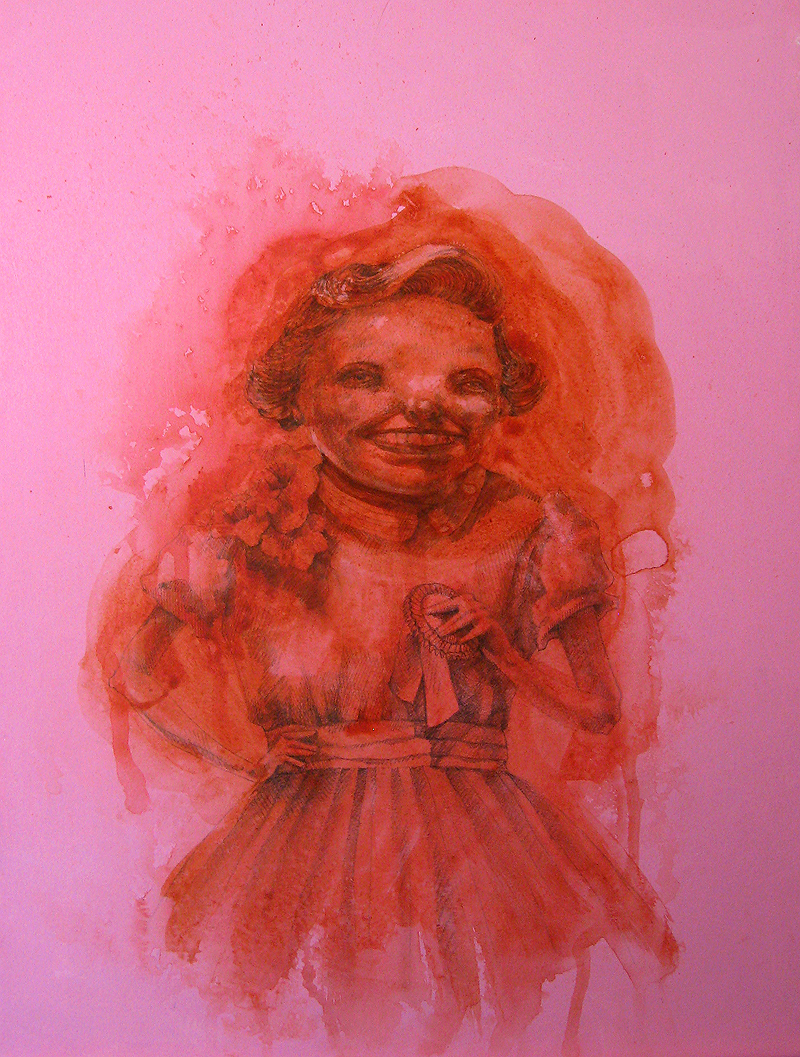
Young Mundy Tulsa, first underpainting.
The Tulsa family's money went down with Penn Square Bank when the bottom dropped out. But Grampa Dewright Tulsa had placed gold and silver coins inside sections of pipe and buried them in the backyard. One day Mundy undertakes to dig a vegetable garden and discovers the coins. This becomes the startup capital for Miz Mundy Cookies, and later Mundy Buns.
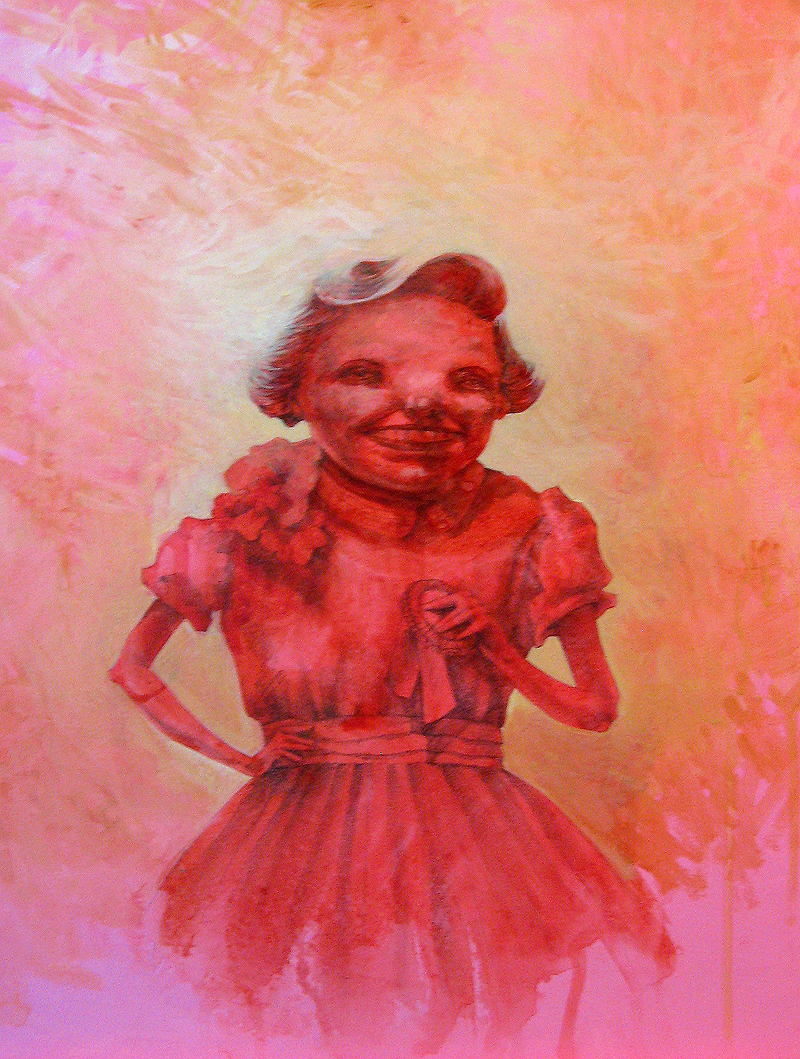
Young Mundy Tulsa, second underpainting.
Mundy Buns grows so successful that Mundy gets a buyout offer from Nabisco. She declines on account of her personal integrity. Soon after, she strikes a deal with Dobbin Wynn to be the exclusive concessions distributor for the Dobbin & Dixie Family Film Fest.
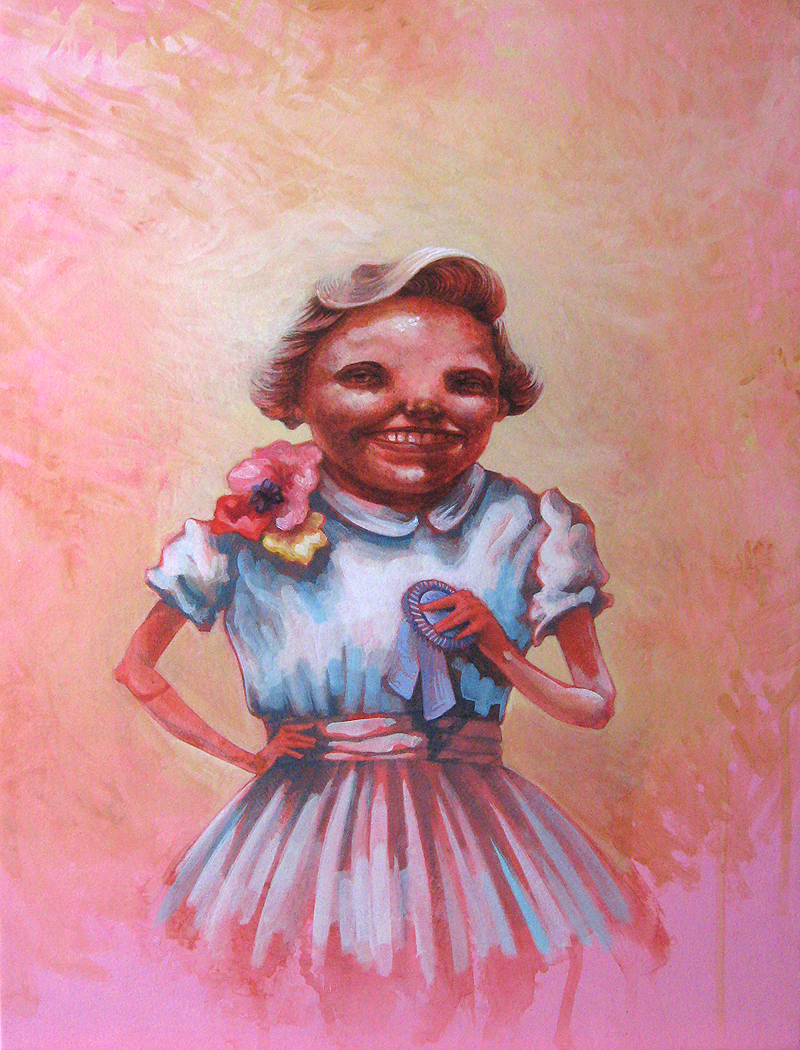
Young Mundy Tulsa, third underpainting.
The Mundy Buns plant remains the economic heart of Normal. Mundy hires Katie Hennepin to help her branch out into organic baked goods.

Normal, OK: Young Mundy Tulsa, graphite and acrylic on paper, 2009
Mundy is seen here at the Opteemah County Fair in 1944, with the blue ribbon she won for her Sweet 'n' Spicy Blackberry Pie.
Back To Normal: Normal, OK Revisited is on display at the Gaylord-Pickens Museum in Oklahoma City through September 19th.
I would like to thank everyone who attended my talk at the show last Saturday, I had a wonderful time. Please join us for the closing reception on Thursday, September 10th, 2009 at 5 pm.
My Inventory Card System

Here's an example of my inventory card system. Click the image to see full-size, or click here to download a 1-page PDF version.
I keep my complete inventory in a stack of 3x5" index cards. When it comes time for a show, I make inventories for the gallery in spreadsheet form, and also in a document with thumbnail images.
Paper and pen are my preferred medium for most applications, but if you'd rather create a digital database of your work, try the GYST company.
Too many index cards cluttering up your desk drawer? Try putting them together into a Hipster.
End Matter - Finishing Touches on a Gallery Show
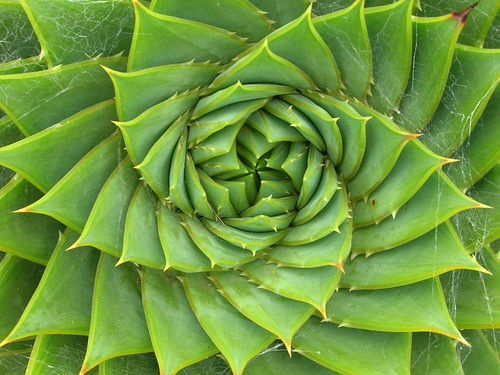
Aloe polyphylla Schönland ex Pillans by Flickr user brewbooks. Click image to view source.
End matter or back matter is a book publishing term that describes all the written elements of a book to be dealt with after the author has finished writing the manuscript. These may include indexes, appendices, glossaries, the table of contents, notes, bibliographies, and so on.
As a gallery artist, I have learned to do a lot more legwork besides making the paintings. I have come to think of certain tasks as the end matter -- what remains to be done after the art is finished. The more of this work I do myself, and do well, before delivering my work to a gallery, the better my professional standing.
Following is some end matter I'm faced with before a gallery show.
Sign and date the work. Sometimes, as with the Normal series, I include a story on the back of the piece. Information like this can increase a painting's value and provenance.
Prepare the painting for hanging in the gallery, either by wiring or framing. I highly recommend Downtown Art & Frame in Norman, OK.
Attach a business card or other identifying information to the back of the piece. This is especially important for group shows where your work might be misidentified.
Photograph the piece. That is, take a good photo, not one with uneven lighting, or glare, or out of focus, etc. The digital formats I use most often are: 300 dpi, 1,000 pixels on a side (for print) 300 dpi, 4 x 6 inches or thereabouts (for print or application to juried shows) 72 dpi, 500-800 pixels on a side (for the web) 72 dpi, 150 pixels on a side (for thumbnails)
Make a backup of the photos, on cd, on the home server, etc.
Upload the image to my website, Flickr, Facebook, etc.
Add the piece to my portfolio, if it's among my best works. Add the piece to my inventory. I'll post more on this later.
Register the work with the copyright office. I keep a text file with an ongoing list of all the works I complete, called "Works By Date." When I finish a piece (or scan a batch of sketchbook pages), I add it to the list. I also keep a folder of small images at 72 dpi, which I will submit as a batch with my copyright registration. When I'm on top of things, I register my work four times a year.
Create an inventory for the gallery. This is so underrated. I make the inventory in two formats:
A spreadsheet containing the title and dates of the show, then the title, medium, dimensions, year, and price for each piece. At the bottom of the spreadsheet I list the show drop-off and pick-up dates, with space for my initials and the curator's. I print two copies: one for me, one for them.
A visual inventory with thumbnail images of each work in the show, followed by titles and prices. (Again, I print two or more copies, and file one for my own reference.) This helps whomever hangs and labels the show, and can also facilitate sales. When a potential buyer calls the gallery asking for the price of a piece, they may only remember it as "That yellow one, with the guy, and that thing in the corner." Having a visual inventory on hand can help avoid all sorts of confusion.
I've learned to leave myself a few days before my deadline to tie up these loose ends. When it's time to ship or deliver my work, I feel much better having all these ducks are in a row.
This post is part of NaBloPoMo for July 2009.
Carrie Ann Baade Interview at Hi Fructose

Wedding Portrait of Madam Himmelblau, oil on panel, 2005 by Carrie Ann Baade. Click image to view source. This painting is from the Secret Lives of Portraits series.
via Right Some Good.
The Hi Fructose blog is featuring an exclusing interview with contemporary pop baroque painter Carrie Ann Baade. Reading Baade's description of her working process, I found that she uses collage as a sketching method, just like I do! Quote:
The spark of the muse that could be called intuition is present when I make the collage for my work. I begin this process by covering the first floor of my house in photos and ripped out pages from books. After the floor is covered I walk around looking for images that fell on top of each other in an interesting manner…this is similar to reading tealeaves. Often I will have a question in mind while diving into the piles of picture images, such as, “What can I say about the horrors of dating in Tallahassee.” This process reminds me of reading tarot cards and getting an answer through the cards that can sometimes be uncannily accurate. Looking for the divine spark to speak to me through these images, I collect and adhere together with cellophane tape to paint later. I know something is really working if I involuntarily laugh aloud at the juxtaposition.
I feel the same intuitive connectivity when I'm making collage sketches. Sometimes the best compositions happen by accident, because I left two scraps in the same pile. I look over and realize, with a little rush of adrenaline, "Of course those go together!"
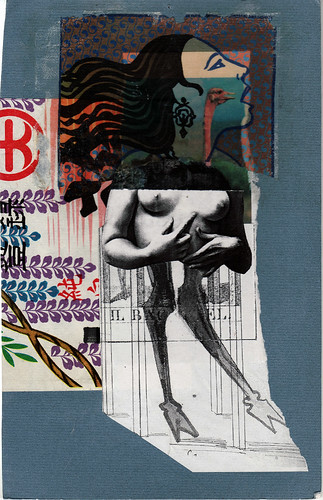
Ostrich, collage sketch, 2007 by Sarah Atlee. Click image to view source.
I like how Baade allows the collage aesthetic to show through in her finished paintings, without her images appearing slapped-together. She does an excellent job of creating integrated compostitions from a variety of sources. The world is a vast grab-bag of information, and our job as artists is to interpret, reinterpret, and dis-cover meaning through our medium. Although Baade has been told that "paint was an inadequate media to display the complexity of [her] ideas," her intricate creations overflow with narrative and emotion. You can explore more of Carrie Ann Baade's work here.
As I was reading this interview on the Hi Fructose blog, I felt an eerie similarity between Baade's collage process and my own. This feeling was redoubled when I saw the previous blog post about the release of Isabel Samaras' new monograph by Chronicle books. The gent on the cover bears an uncanny resemblance to this guy here. The similarity is a coincidence.
This post is part of NaBloPoMo for July 2009.

